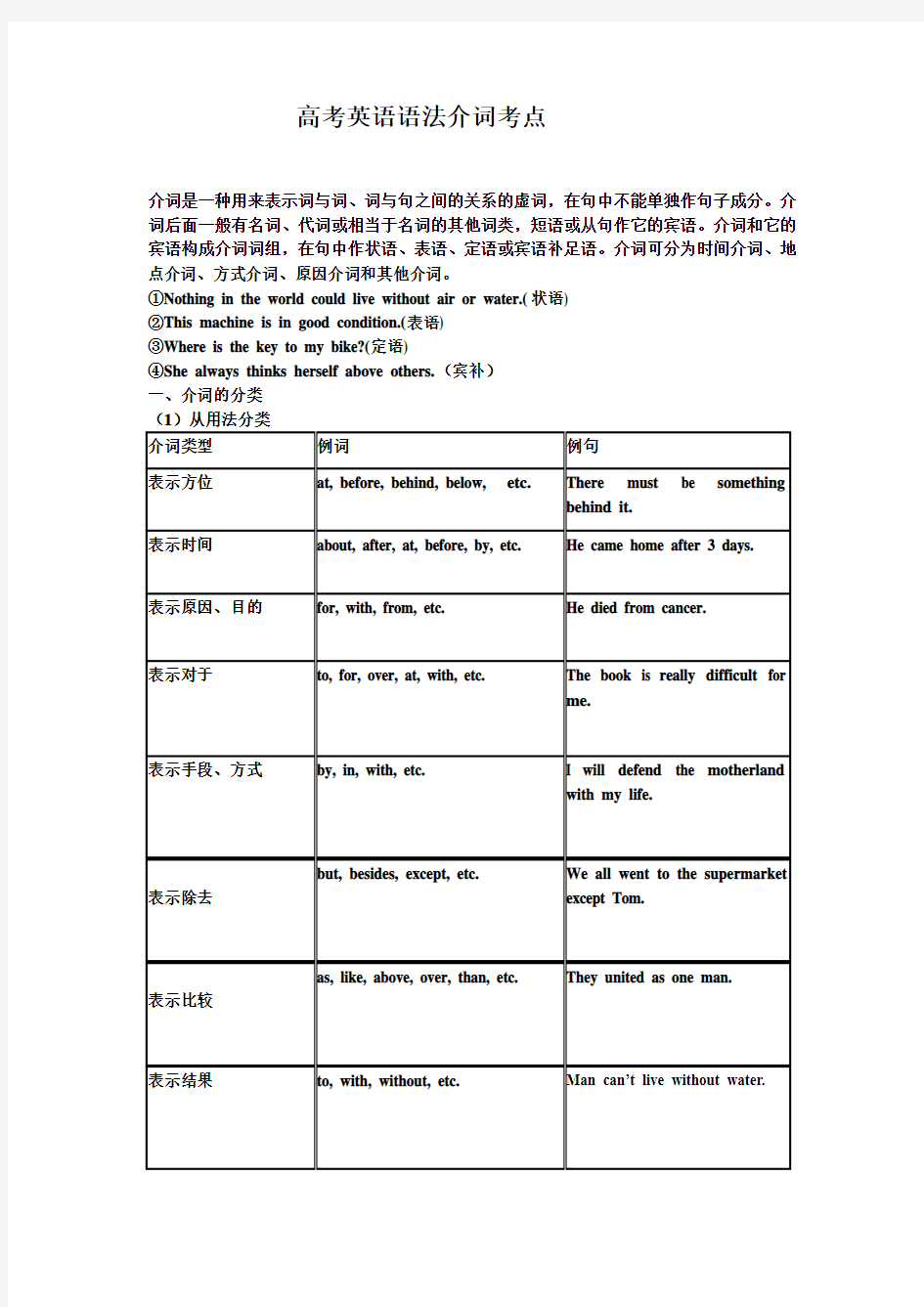
高考英语语法介词考点
- 格式:doc
- 大小:57.00 KB
- 文档页数:7


高考英语语法介词考点
介词是一种用来表示词与词、词与句之间的关系的虚词,在句中不能单独作句子成分。介词后面一般有名词、代词或相当于名词的其他词类,短语或从句作它的宾语。介词和它的宾语构成介词词组,在句中作状语、表语、定语或宾语补足语。介词可分为时间介词、地点介词、方式介词、原因介词和其他介词。
①Nothing in the world could live without air or water.(状语)
②This machine is in good condition.(表语)
③Where is the key to my bike?(定语)
④She always thinks herself above others.(宾补)
一、介词的分类
(1)从用法分类
(2)从结构分类
【考点一】考查with/without复合结构
介词with/without+名词/代词+形容词/副词/介词短语/动词不定式/分词(分词可以是现在分词,也可以是过去分词)在句中表状态或说明背景情况,常作伴随、方式、原因、条件等状语。
With all the things she needed bought, she went home happily.
Possibly this person died without anyone knowing where the coins were hidden.
单项填空
①It was a pity that the great writer died _____ his works unfinished.
A. for
B. with
C. from
D. of
解析:选B。考查with复合结构。works 与unfinish之间为动宾关系,所以用过去分词表示被动。如果名词或代词与后面的动词是主谓关系,则用现在分词表示主动。
【考点二】考查工具、手段、方式介词
(1)by, in, on三词都可表示旅行的方式
①不涉及交通工具的名词时用by,名词前不加冠词。如by sea, by water, by land, by rail, by air等。
②涉及交通工具的名词时用by,名词须用单数形式,前面不加冠词或任何修饰语。如by bike, by taxi, by plane, by ship/boat, by train, by spaceship等。
③当旅行方式涉及确定特指的交通工具时,用on或in,名词前加冠词、物主代词、指示代词等修饰语。如travel to New York in this plane,leave on an early train,go to school on my bike等。
注意:步行、骑马、骑骆驼均用on。如on foot,on horseback,on a horse,on the camel。(2)with, by, in三词均意为“用”,表示行为的工具、手段或方式。
①with用于有形的工具或身体某些器官之前,其后的名词多被冠词、物主代词等修饰。They are digging with a pick/spade.
We see with our eyes, hear with our ears, and walk with our legs.
②by, in, on, over, through等介词多用于无形的工具或方式手段之前。如by hand, in ink, on the telephone, over the radio, through the telescope等。
注意:①使用语言、原料、材料时,用in表示,如in English/Japanese;in blue ink等。②表达“用……方法/式”时,所用介词有:in this/that/the same way,by means of,by this/that means,with this/that method等。
【考点三】考查of+抽象名词的用法
“of+抽象名词”的用法与形容词相同,在句中可作表语、定语、补语。
of+great/much +抽象名词=very+名词的形容词形式
of+no+抽象名词=not+名词的形容词形式
It is of great value.=It is very valuable.
It is of no use.=It is useless.
The camel is of great help to the Arab.
=The camel is very helpful to the Arab.
【考点四】考查表示程度的介词by, to, beyond
by 表示“增加了……”;to表示“增加到……”;beyond表示“范围, 限度超出”。
This new model of car is so expensive that it is beyond the reach of those with average incomes.
单项填空
②Sorry, Madam. You’d better come tomorrow because it’s ______ the visiting hours.
A. during
B. at
C. beyond
D. before
解析:选C。考查介词的用法。句意为:对不起,女士,你最好明天来,因为已经过了开放时间了。beyond(时间)晚于,迟于。
【考点五】考查介词but的固定搭配
have no choice but to do只得做某事;can’t help but do不得不做……;can’t but do不得不只能;can’t choose but do只得做某事;but for要不是……。
I have no choice but to accept his conditions.
There was no taxi that day, I couldn’t choose but stay there for
another night.
【考点六】考查to one’s+情感类名词
to 与情感类名词连用,表示“某人因某事的发生而唤起其内心的某种情感”。常见的结构有:to+one’s+delight/surprise/horror/sorrow/joy/regret=to the delight/surprise/horror/sorrow/joy/regret of sb.。这种结构表示结果,用作状语,通常置于句首,也可置于句中或句末。若要加强该结构的语气,有两种方式:①在名词前加great, deep 等形容词修饰;②在整个短语前加副词greatly, much等修饰。
To his disappointment, he failed again.
【考点七】考查名词与to构成的固定搭配
key, approach, solution, answer, entrance, visit, attitude等与to构成固定搭配:the key/approach/solution/answer/entrance/visit/attitude to...。
It is said that they have adopted a new approach to teaching English.
【考点八】考查介词by的用法
(1)by+地点名词。表示方位,意为“在……旁边”。
注意:表示“从……旁边经过”时,多与动词go/walk/pass等词连用。
(2)by+时间名词,意为“到……时(已发生某事);最晚,不迟于……,在……之前”,此时谓语多用完成时。
(3)by+名词。可用来表示方法、方式、手段等。
①by+the+可数名词(时间、长度、重量等),意为“按……计算;按……买(卖)”。
②by+表示时间、长度、重量等总称的不可数名词(名词前不加冠词),意为“按……计算,按……买(卖)”。
③by+表示交通工具、交通方式名词(名词前不加冠词,不用复数),意为“通过……;由……;乘……”。
④by+抽象名词或具有抽象意义的普通名词(名词前不加冠词,不用复数),意为“靠……;通过……;由……所致”。
⑤by+地点或工具等具体名词。表示路线、途径,意为“通过(某物、某地);取道……”。